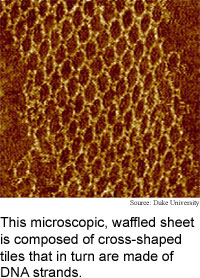
DNA forms nano waffles
By
Kimberly Patch,
Technology Research NewsResearchers are working to control the way DNA strands interact with each other in order to coax the molecules to form tiny structures. Such structures could eventually serve as microscopic machines and as templates capable of causing other materials and devices to automatically assemble molecule-by-molecule.
Researchers from Duke University have moved DNA construction methods a step forward by coaxing DNA strands to lock together into tiles made up of nine single strands of DNA that can further self-assemble into lattices. The ribbon- and sheet-shaped lattices can be used as devices or as templates to construct devices from other materials.
The researchers demonstrated one set of tiles that self-assembled into a tiny protein detector, and another set that assembled into ribbons that served as templates for precisely formed silver nanowires.
DNA is made up of four bases -- adenine, cytosine, guanine and thymine -- attached to a sugar-phosphate backbone. Strands of DNA connect to each other when strings of bases pair up -- adenine with thymine, and cytosine with guanine.
The tiles form when single-stranded DNA molecules self-assemble into a branched structure, said Hao Yan, an assistant research professor of computer science at Duke University. "We make the DNA strands arrange themselves into cross-shaped tiles capable of forming molecular bonds on all four ends of the cross arms," said Yan.
The researchers were able to make the tiles connect to each other to form a square, waffle-patterned grid or a waffle-patterned long ribbon by making tiles with different "sticky end" configurations. Sticky ends are portions of DNA strands that remain unconnected when the nine DNA strands connect together to form the tile and can later connect to matching DNA segments. "DNA tiles can carry sticky ends that preferentially match the sticky ends of another particular DNA tile," said Yan.
The tiles were originally designed to form perfectly flat lattices, but when the researchers reprogrammed the tiles by changing the sticky ends so that the tile faces would all orient in the same direction up or down, the tiles curved slightly in opposite directions to form a long, narrow ribbon whose surfaces were waffled, said Yan. A second modification that caused each tile face to point in the opposite direction from its neighbor resulted in the wider grid structure.
The method is particularly useful because "we can easily achieve two types of lattice by slightly changing the sticky-ends without changing the tile structure itself," said Yan.
DNA makes a useful template because many other materials can chemically attach to DNA. "Self-assembled DNA arrays provide excellent templates for spatially positioning other molecules with... precision," said Yan.
The researchers formed a device that detects the protein streptavidin by adding the molecule biotin to one of the DNA strands in each grid tile. Streptavidin connects to biotin.
The researchers made precisely-formed silver nanowire using the ribbon structure, said Yan. "We used a two-step chemical procedure to coat silver onto the DNA nanoribbons to produce electricity-conducting nanowires," he said.
Such wire can eventually be used to interconnect nanoscale devices with micron-scale devices, said Yan. Connecting relatively large microscopic objects, like those around the size of a cell, to relatively small ones, like those around the size of a molecule, is a major challenge simply because the size difference is so vast. A red blood cell, for instance, is, at 5 microns across, about 15 times narrower than a human hair, but 50,000 times larger than a hydrogen atom.
The method could eventually be used to construct many types of materials and devices, including electronics, molecule-by-molecule. Such precise control over construction promises to enable materials that have new properties, and electronics that are very efficient.
The researchers are working on designing more complicated DNA nanostructures and working out chemical methods to attach nanoelectronic components like carbon nanotubes to DNA, he said.
The ultimate goal is to use DNA as a scaffold to organize any useful material into nano-size devices, sensors and even factories, said Yan.
The technology could be ready for practical applications within five years, said Yan.
Yan's research colleagues were Sung Ha Park, Gleb Finkelstein, John H. Reif and Thomas H. LaBean. The work appeared in the September 26, 2003 issue of Science. The research was funded by the National Science Foundation (NSF) and the Defense Advanced Research Projects Agency (DARPA).
Timeline: 5 years
Funding: Government
TRN Categories: Nanotechnology; Biotechnology; Materials Science and Engineering
Story Type: News
Related Elements: Technical paper, "DNA-Templated Self-Assembly of Protein Arrays and Highly Conductive Nanowires," Science, September 26, 2003
Advertisements:
October 22/29, 2003
Page One
Body network gains speed
Queries guide Web crawlers
Nanowires make flexible circuits
DNA forms nano waffles
Briefs:
Fiber handles powerful pulses
Process prints nanoparticles
Single electrons perform logic
Embedded rotors mix fluids
Nanowires boost plastic circuits
Chip mixes droplets faster

News:
Research News Roundup
Research Watch blog
Features:
View from the High Ground Q&A
How It Works
RSS Feeds:
News
Ad links:
Buy an ad link
| Advertisements:
|
 |
Ad links: Clear History
Buy an ad link
|
TRN
Newswire and Headline Feeds for Web sites
|
© Copyright Technology Research News, LLC 2000-2006. All rights reserved.